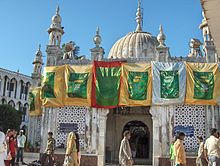Haji Ali Dargah is a dargah (tomb) or the monument of Pir Haji Ali Shah Bukhari located on an islet off the coast of Worli in the southern part of Mumbai. Pir Haji Ali Shah Bukhari was a Sufi saint and a wealthy merchant from Uzbekistan. Near the heart of the city proper, the dargah is one of the most recognizable landmarks of Mumbai.
Sayyed Peer Haji Ali Shah Bukhari was a wealthy merchant. Through Ilm (Wisdom of Faith), many miracles and acts of faith were known to be performed by him. In the initial days of the spread of Islam in India, it was travelers and Sufi saints like him who settled amongst the local people and disseminated the message of Islam. When the Sultanate ruled over the island of Worli, at some point Peer Haji Ali came to settle there. Many legends point out that during his journey to Mecca, he fell ill and died, and on his request, his followers cast his body into the sea. Earlier in his life, the Peer had helped a poor woman recover some oil by jabbing a finger into the earth. This act later filled him with remorse, so much that he did not want to injure the earth more. The casket carrying his coffin floated back to the shores near Worli. Today, a humble yet eye-catching tomb stands at this spot amongst the rocks, some 500 meters into the sea. The saint gave up all his wealth and material possessions to make a pilgrimage to Mecca. Then, after traveling around the world, he settled in one of the islands that today make up the city of Mumbai and dedicated his life to propagating Sufism in the area
The Dargah is built on a tiny islet located 500 meters from the coast, in the middle of Worli Bay,in the vicinity of Worli. The edifice is a brilliant specimen of the Indo-Islamic style of architecture. The islet is linked to the city precinct of Mahalakshmi by a narrow causeway, which is nearly a kilometre (0.62 mile) long.
The accessibility to the dargah is very much dependent on the tides. As, the causeway is not bound by railings, when the causeway gets submerged during high tide it becomes inaccessible. Therefore, the dargah is accessible only during low tide. This walk on the causeway, with the sea on both sides, is one of the highlights of a trip to the shrine.
Haji Ali Dargah :
The whitewashed structure occupies an area of a marble courtyard contains the central shrine. The tomb within the mosque is covered by a brocaded red and green chaddar (tomb cover sheet). It is supported by an exquisite silver frame, supported by marble pillars. The main hall has marble pillars embellished with artistic mirror work: blue, green, yellow chips of glass arranged in kaleidoscopic patterns interspersed with Arabic patterns which spell the ninety-nine names of Allah. As per the Muslim traditions separate praying rooms for ladies and gents are provided here to pay their respects. During the high tide, the dargah seems completely isolated with no access. It looks more like a little island.

